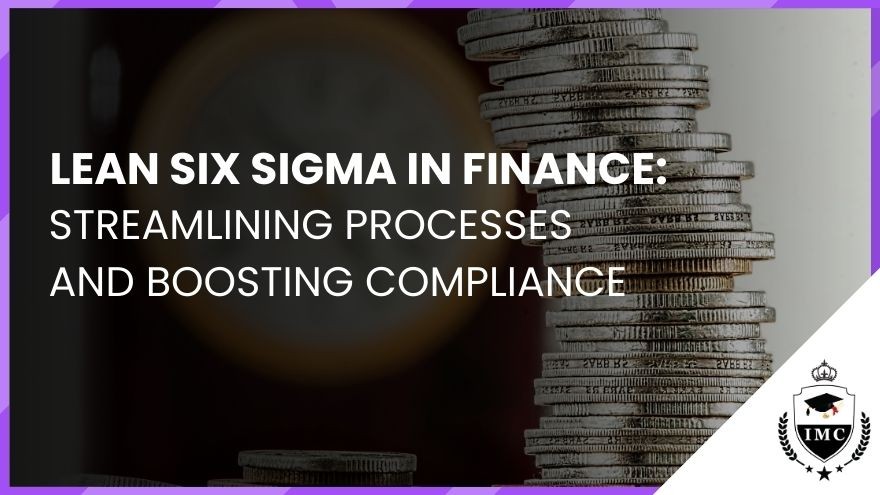The finance industry is synonymous with precision, compliance, and efficiency. Financial organizations must manage vast volumes of transactions, ensure strict adherence to regulations, and constantly evolve to meet new customer expectations. In such a demanding environment, Lean Six Sigma has become an invaluable methodology to streamline processes, enhance operational efficiency, and improve compliance.
At IMC Institute, we recognize the transformative power of Lean Six Sigma in the finance sector. That's why we offer comprehensive certification programs across all levels—Yellow, Green, Black, and Master Black Belt—designed to equip professionals with the tools they need to make a significant impact. Additionally, our PMP certification, accredited by PMI, complements Lean Six Sigma training by focusing on project management expertise. As part of our ongoing effort to support professional development, we offer a 50% discount to those enrolling in both Lean Six Sigma and PMP certification programs.
The Role of Lean Six Sigma in Finance
Lean Six Sigma combines the efficiency-driven mindset of Lean with the rigorous statistical approach of Six Sigma to eliminate waste, reduce errors, and improve overall processes. In the finance industry, the application of Lean Six Sigma can be observed in several key areas:
- Process Optimization: Lean Six Sigma methodologies help finance companies eliminate bottlenecks and reduce process inefficiencies.
- Regulatory Compliance: With financial institutions facing ever-increasing regulatory scrutiny, Lean Six Sigma can streamline compliance processes.
- Error Reduction: Reducing the margin of error in financial transactions is critical, and Lean Six Sigma’s data-driven approach helps minimize mistakes.
- Customer Satisfaction: The finance industry, like many others, is increasingly customer-centric. Lean Six Sigma can improve response times, simplify processes, and enhance service delivery.
Real-World Examples of Lean Six Sigma in Finance
1. Bank of America’s Lean Six Sigma Journey
One of the most well-known examples of Lean Six Sigma implementation in finance is Bank of America. Facing inefficiencies in its mortgage-processing division, Bank of America embraced Lean Six Sigma to optimize its operations. The company reduced cycle times and improved customer satisfaction by analyzing data and eliminating redundant steps in its processes. This initiative also led to significant cost savings, making the bank more competitive and agile.
2. American Express Reducing Transaction Errors
American Express applied Lean Six Sigma to reduce errors in its credit card transaction process. By mapping out the entire process and identifying problem areas, they were able to streamline operations, improve transaction accuracy, and enhance customer experience. As a result, American Express not only reduced costs associated with transactional errors but also boosted customer trust and loyalty.
3. SunTrust Banks Improving Loan Processing
SunTrust Banks utilized Lean Six Sigma to revamp their loan processing system. The project identified inefficiencies in their approval workflow, particularly in the hand-off points between departments. By implementing changes, SunTrust reduced approval times, enhanced communication between teams, and ultimately increased customer satisfaction. This improvement also enabled SunTrust to maintain better compliance with regulatory requirements, crucial in today’s financial landscape.
Benefits of Lean Six Sigma for Financial Institutions
1. Increased Efficiency and Reduced Costs
Lean Six Sigma’s focus on eliminating waste leads to more efficient financial operations. By identifying non-value-added activities, financial organizations can cut down on redundancies, thereby reducing operational costs. For instance, banks that process mortgage applications more efficiently can reduce costs while maintaining or even improving service levels.
2. Enhanced Regulatory Compliance
In finance, compliance with regulations is a must. Lean Six Sigma helps organizations develop processes that meet regulatory requirements consistently, thus avoiding costly penalties. The methodology's systematic approach ensures that every step adheres to both internal and external compliance standards.
3. Improved Customer Experience
Financial services have become highly competitive, with customers expecting fast and reliable service. Lean Six Sigma enables organizations to enhance their customer-facing processes, reducing wait times, simplifying procedures, and ultimately boosting customer satisfaction. In the case of American Express, their use of Lean Six Sigma to reduce transaction errors led to improved customer relationships.
4. Risk Management and Error Reduction
In finance, even minor errors can have severe consequences. Lean Six Sigma’s focus on data and process control minimizes the chances of errors in critical areas such as transaction processing, loan approvals, and audits. This increased accuracy helps financial organizations manage risks more effectively.
The Importance of Lean Six Sigma Certification
Professionals in the finance industry looking to make a significant impact should strongly consider obtaining Lean Six Sigma certification. IMC Institute offers all four belt levels—Yellow, Green, Black, and Master Black Belt—each designed to provide a different level of expertise. From improving processes at the operational level to leading large-scale transformation initiatives, these certifications can help professionals advance their careers while making measurable improvements in their organizations.
Moreover, financial professionals can enhance their project management skills with our PMP certification, accredited by PMI. By combining Lean Six Sigma and PMP certifications, finance professionals can become well-rounded leaders capable of driving efficiency, managing risks, and ensuring compliance across departments.
Why Choose IMC Institute?
At IMC Institute, we are committed to empowering professionals with the tools and knowledge they need to succeed. Our Lean Six Sigma certifications offer:
- Real-World Applications: Our curriculum focuses on practical applications, so you can immediately apply what you learn to your organization.
- Comprehensive Training: We offer all four levels of Lean Six Sigma certifications—Yellow, Green, Black, and Master Black Belt—so you can progress from basic to expert-level mastery.
- Global Recognition: Our Lean Six Sigma and PMP certifications are recognized worldwide, giving you the credentials you need to stand out in a competitive job market.
Special Offer: 50% Off for Dual Certification
As a special promotion, IMC Institute is offering a 50% discount for anyone who enrolls in both Lean Six Sigma and PMP certification programs. This combination provides finance professionals with the perfect blend of process optimization and project management skills, enabling them to deliver impactful results in their organizations.
Summary
The finance industry is under constant pressure to improve processes, enhance compliance, and deliver exceptional customer service. Lean Six Sigma offers financial institutions the tools to meet these challenges head-on. With real-world examples like Bank of America, American Express, and SunTrust Banks showcasing the power of Lean Six Sigma, it’s clear that this methodology can bring about significant improvements in efficiency, compliance, and customer satisfaction.
At IMC Institute, we are committed to helping finance professionals master Lean Six Sigma and make a tangible impact in their organizations. Whether you are just starting your Lean Six Sigma journey or looking to advance to higher belt levels, we have the training and resources you need. Don’t miss out on our 50% discount when you enroll in both Lean Six Sigma and PMP certifications—invest in your future today.
For more information, visit IMC Institute and start your Lean Six Sigma journey.






